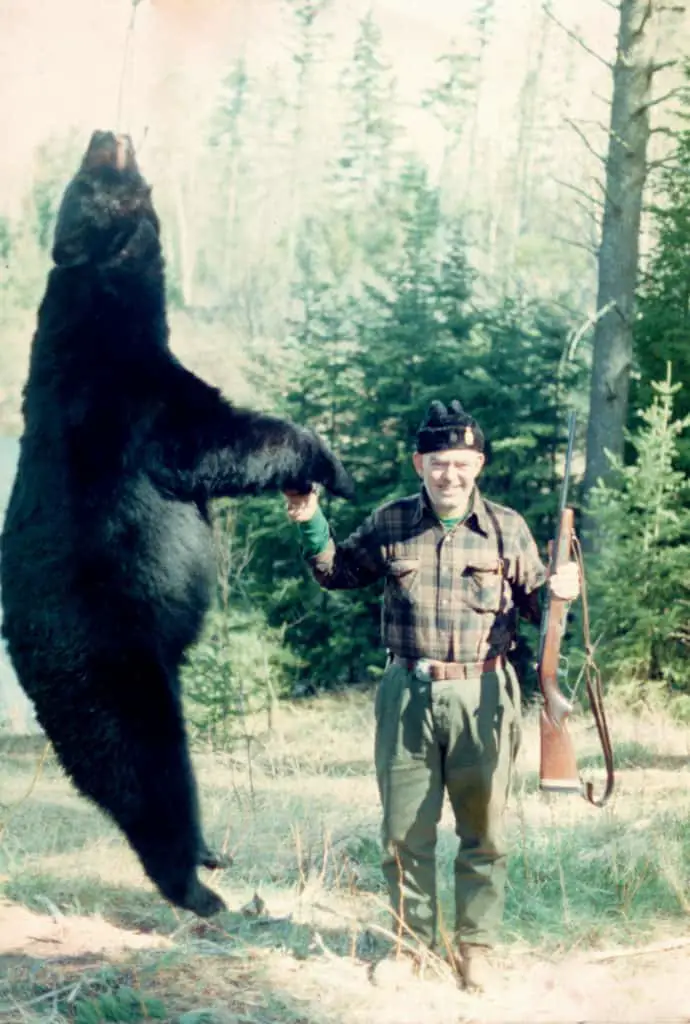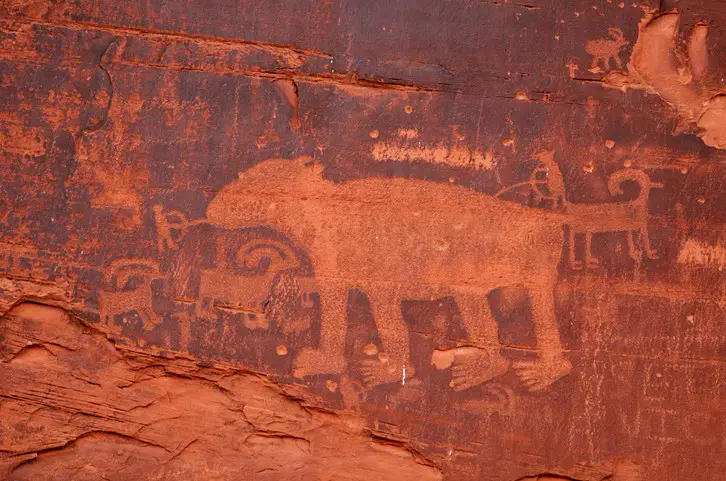Honestly, the best bear hunting tips for bear hunters should start with this: No one is less willing to hunt a bear than someone who’s been successful.
What a terrible way to start an article on bear hunting, right? However, it is true. The successful first-time bear hunter is often unprepared for the miserable buzzing clouds of bugs that come with gutting a bear. Nor are they in any shape for the incredible physical effort to drag hundreds of pounds of inert jello. Finally, at their vehicle, there awaits the impossible task of raising the bear carcass into the back of their truck.

Four bear hunting tips for bear hunters.
All bear hunters should know where to shoot the bear, be physically prepared to field dress, drag, and secure their harvest to a vehicle, and have a hunting plan that includes contacts for additional help, the location and times you will be hunting, and the resources to preserve their harvest.
Related: How to tell a sow from a boar.
Bear hunting tip #1: Know before you go.
Learn how to field a dress a bear before you go hunting. Field dressing a bear is just the first task in a long line of ”to-do” lists for ending a successful hunt. Killing a bear and then trying to figure out a way to properly gut it is a recipe for disaster. As an ethical bear hunter, you should have all the knowledge and tools necessary to ensure your harvest is edible and, if desired, mountable.
There is a good chance a proper understanding of what you need to do after harvesting a bear will turn you away from the sport. That’s okay! In the long run, it could help you avoid a massive wanton waste fine and perhaps lose your hunting privileges.
Watch the video below at least once before moving on. If you need to, download it and have it ready to help you in the field—where cell service may be limited or nonexistent.
Related: How to call a black bear during the fall feeding frenzy.
Bear hunting tip #2 for bear hunters: Have a plan to get the bear home.
Have a plan to transport hundreds of pounds of jello. Dragging a bear will be the hardest thing you will ever do in the woods. It’s hard to get any momentum; the bear’s limbs and claws will tangle and seize hold of every rock, branch, and twig.
Your best bet is to either have a friend to help you or take your bear with a dead-right-there shot in a location where you can at least get at it with an ATV and a sled to help pull it.
If you must hunt by yourself, you can opt for a tow-wheeled game cart. If you have a long haul ahead, consider quartering the bear in the field. This sounds hard to do, but it isn’t, and it has many advantages, including lightening your load and keeping the bear’s meat clean.
Related: Bear hunting tips for first timer bear hunters.
You can check out many of Fred Eichler’s free TV programs on Amazon here.
Bear hunting tips #3: Proper bear shot placement.
As an ethical hunter, you must first be willing to admit to yourself what your true capabilities are with your rifle or bow. Half your skills will evaporate in the heat of a thundering heart, gasping lungs, and trembling hands the first time you aim at a bear. A poor shot on the range is easily dismissed. A poor shot on a bear in the field is a long-distance chase.
Like all quadrupeds, the vital zone is best reached through a broadside or quartering away shot. Head shots, frontal shots, and tree stand shots fired from directly above are seriously discouraged—they almost always fail to result in a dead-right-there bear. If you’re smart, you spent some time honing your skills on hitting the perfect places to shoot coyotes and deer.
The average size of a bear’s sweet spot (the heart and lungs) is about eight inches. On a broadside or quartering away shot, always wait to shoot until the bear moves the leg facing you forward. This step moves the shoulder and humerus bones out of the way and exposes the vital organs. Hitting the shoulder or humerus will result in blocked arrows or deflected rounds.
Related: What does black bear poop look like?
Bear hunting tips #4: A plan to succeed and survive.
I pity the first-time bear hunter who doesn’t have a detailed plan and still foolishly steps into the woods. The best they can hope for is a physically exhausting and bug-ridden experience they will never again attempt to replicate. At worst, they will be forced to abandon their harvest and never admit to the shame of what they have done.
A physically unprepared bear hunter could face even dire consequences. Realizing only as they fall next to their harvest, years of sedentary office work and undiagnosed heart disease were better suited to squirrel hunting.
The last big surprise most bear hunters have not planned is warm temperatures. Many bear hunting seasons occur during months with temperatures above freezing. Bear meat spoils fast, and often the first (best) step is to skin the hide to start the body cooling down. Cutting, rolling, and shoving a 300-hundred-pound bear is an expletive-filled nightmare.
It may seem heartless at this point to even mention it—seriously who wants to even think about toting even more weight around—but what you will need is ice. Packing ice into body and amongst the quarters greatly reduces the chance of meat spoilage.
Without a perfect plan, more than bear meat can be wasted. You can lose your hunting privileges just because you field dressed your bear incorrectly and removed the sex.

Have a plan for a successful bear hunting day.
Make sure you know where to shoot the bear, are physically prepared to field dress, drag, and secure their harvest to a vehicle, and have a hunting plan that includes contacts for additional help, the location and times you will be hunting, and the resources to preserve their harvest.

